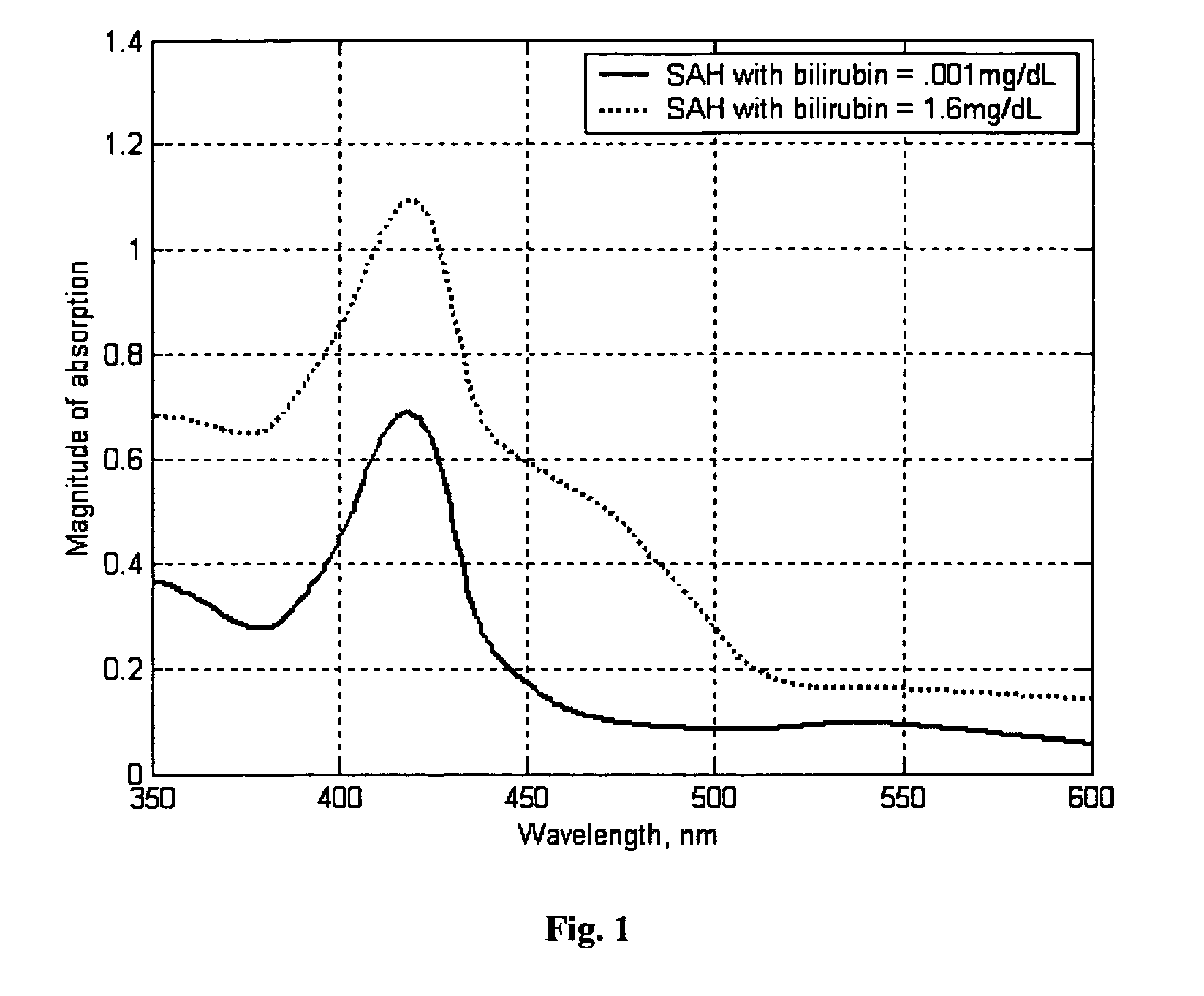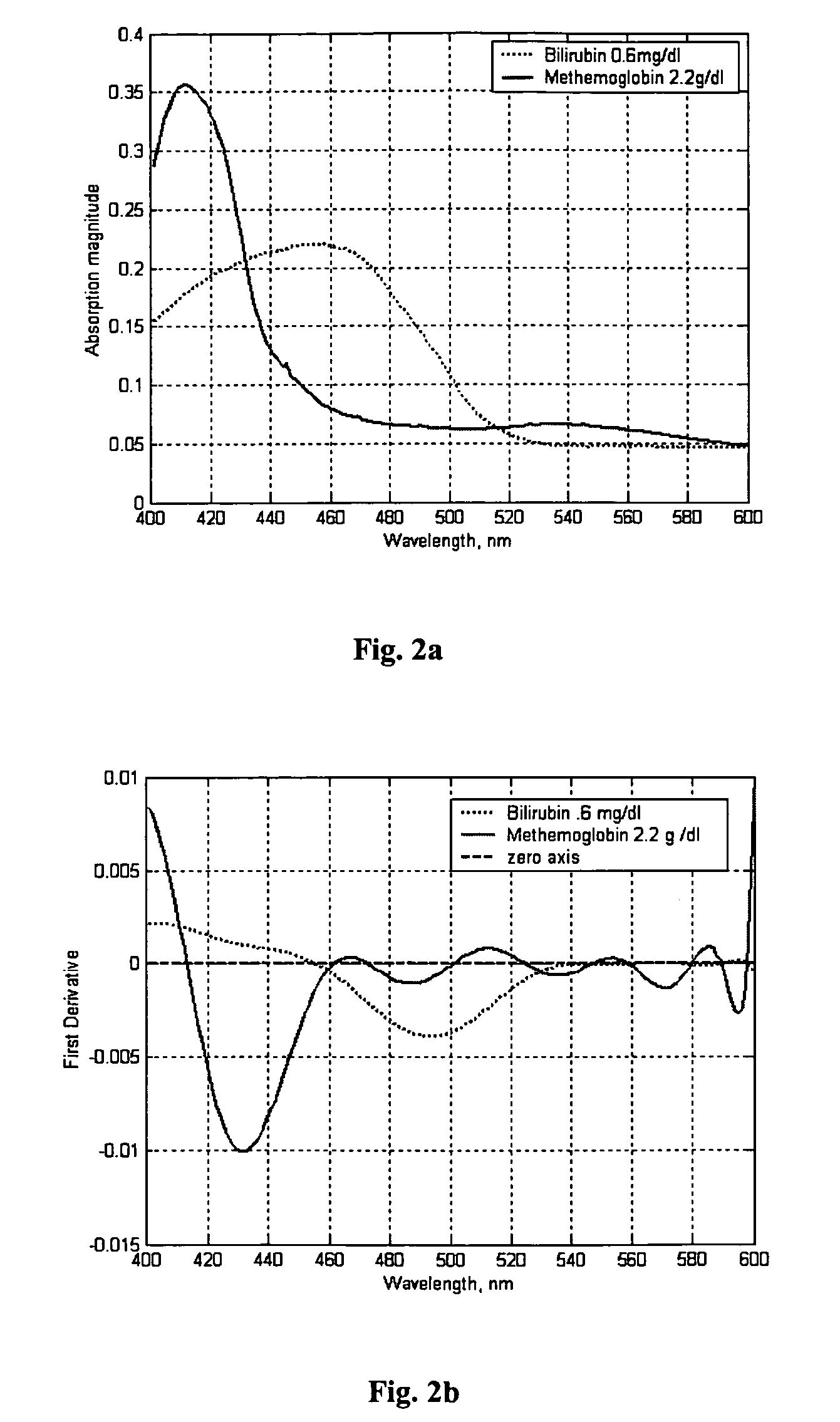Methods for assessing a condition by analyzing blood in cerebrospinal fluid
a cerebrospinal fluid and analysis method technology, applied in the direction of optical radiation measurement, instruments, spectrometry/spectrophotometry/monochromators, etc., can solve the problems of traumatic tap, no test can reliably identify the source of blood in csf, and clinicians do not possess sufficient diagnostic modalities for assessing, etc., to achieve accurate diagnosis of patients and reliable quantitative results
- Summary
- Abstract
- Description
- Claims
- Application Information
AI Technical Summary
Benefits of technology
Problems solved by technology
Method used
Image
Examples
example 1
[0086]This example illustrates the use of the inventive methods to perform a differential diagnosis the spectrophotometer output provides the spectral content of the CSF obtained from LP. Generally, due to the rupture of a blood vessel while performing LP, the spectral content would consist of hemoglobin and bilirubin. The hemoglobin consists of two different components: oxyhemoglobin and methemoglobin. However, within a short period of time, the oxy-hemoglobin gets converted into methemoglobin. Therefore, the primary objective is to detect the presence of bilirubin in CSF-SAH. In addition to bilirubin (the concentration of which depends on the extent of aneurysm rupture), CSF-SAH may have methemoglobin and certain other proteins in it. A measured spectral output for SAH was generated and CSF / SAH with two different concentrations of bilirubin were plotted. It was observed that absorption increased over all wavelength ranges for the higher bilirubin concentration but was more pronoun...
example 2
[0088]This example illustrates the calculation of scaling factors in the development of the minimum distance method algorithm employed in some embodiments of the inventive methods.
[0089]The performance of the algorithm depends on the ability to describe the measured SAH spectrum accurately as the linear combination of pre-measured bilirubin and methemoglobin spectra over the wavelengths of significance, i.e., between 390 and 420 nm and 450 to 600 nm. Therefore, over a certain set of wavelengths in the spectral data, we adjust the SAH curve with a scale factor
S(n)=α*SAH(n)≈(B(n)+M(n)) 390≦n≦420 (1)
S(n)=β*SAH(n)≈(B(n)+M(n)) 450≦n≦500 (2)
where, α and β are scaling factors which are computed by minimizing the least squares (LS) error functions
εi(1)=Σ∥(α·SAHi(n)−(Mi(n)+Bi(n))∥2 390≦n≦420 (3)
εi(2)=Σ∥(β·SAHi(n)−(Mi(n)+Bi(n))∥2 450≦n≦500 (4)
such that the scaled SAH curve and the sum curve are nearly equal over the wavelengths indicated.
[0090]A set of solutions is prepared in which methe...
example 3
[0092]This example provides results of estimating bilirubin and methemoglobin in a measured CSF / SAH solution using the minimum distance method.
[0093]First, M (n) and B (n) were estimated in a sample with constant methemoglobin and increasing bilirubin. Spectral curves for 36 different concentrations of methemoglobin and bilirubin were measured in the laboratory, 105 additional curves were interpolated from those as discussed previously. The methemoglobin concentration was held constant at 4.6 g / dL while the bilirubin concentration was increased from 0 mg / dL to 9 mg / dL. The bilirubin concentrations were not uniformly distributed over the entire concentration range. Since the lower and middle levels on the concentration scale are more critical in terms of diagnosis of SAH, the number of concentrations of bilirubin measured in this region is higher. This helps us test the algorithm more rigorously over the critical concentrations of bilirubin.
[0094]The results indicate that the estimat...
PUM
 Login to View More
Login to View More Abstract
Description
Claims
Application Information
 Login to View More
Login to View More - R&D
- Intellectual Property
- Life Sciences
- Materials
- Tech Scout
- Unparalleled Data Quality
- Higher Quality Content
- 60% Fewer Hallucinations
Browse by: Latest US Patents, China's latest patents, Technical Efficacy Thesaurus, Application Domain, Technology Topic, Popular Technical Reports.
© 2025 PatSnap. All rights reserved.Legal|Privacy policy|Modern Slavery Act Transparency Statement|Sitemap|About US| Contact US: help@patsnap.com



